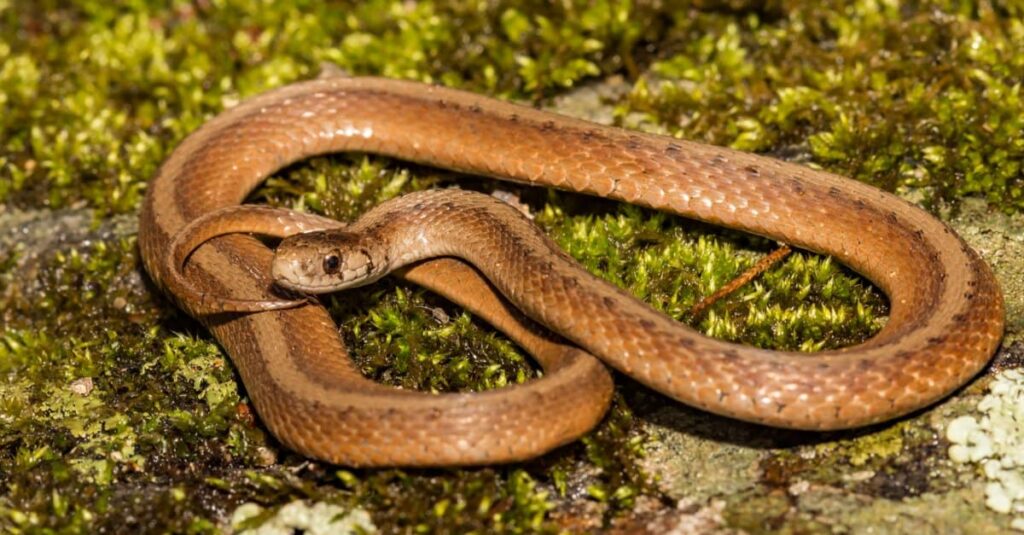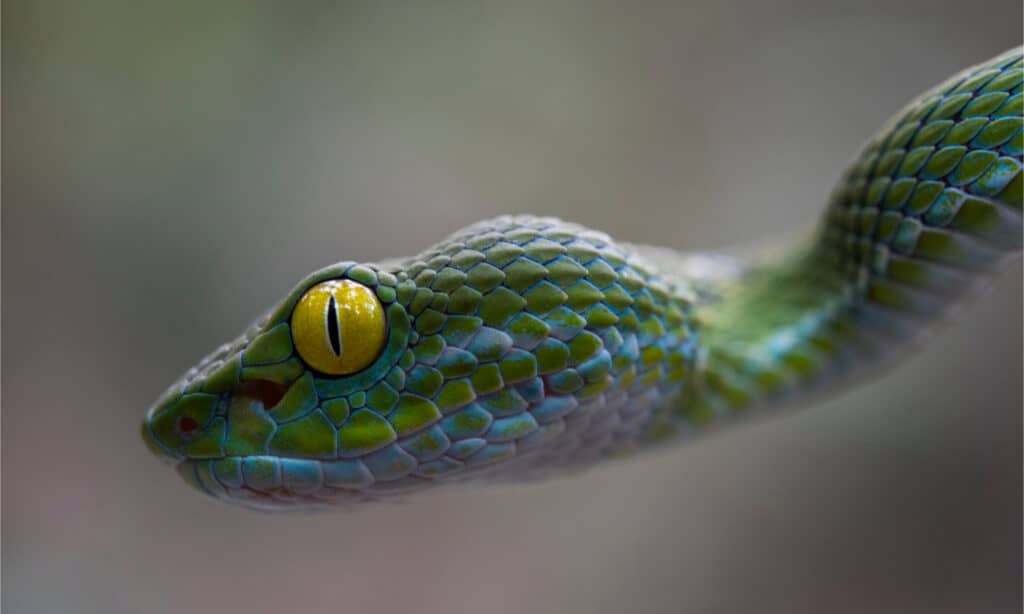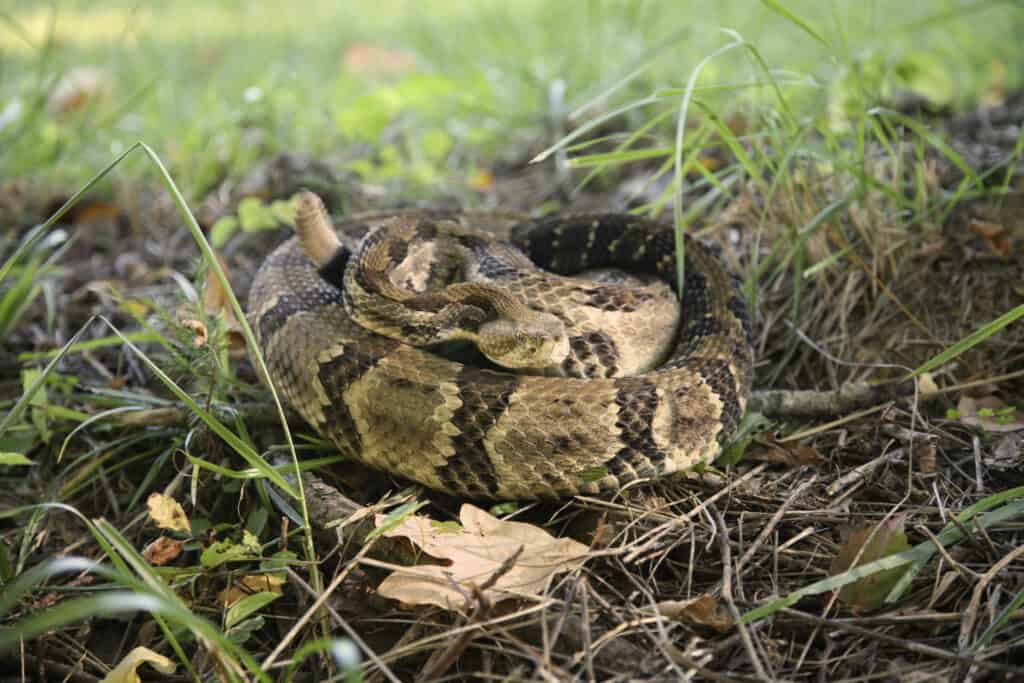Love ’em or hate ’em, snakes live on every continent except Antarctica. Without them, rats would rule the world because these legless predators are largely responsible for the world’s rodent control. Still, if snakes are on your list of “No. Never. Please get it away from me” critters, remember that only a small percentage of snakes are dangerous. According to the Delaware Department of Natural Resources and Environmental Control, the tiny state has 19 snake species. Only two are venomous, and they don’t even make the top 10 most common snakes in Delaware. Here’s our list of the top five Delaware garden snakes, according to sightings reported on iNaturalist.org. While far from a perfect population measurement, these sightings give a pretty good idea of which snakes you’re most likely to see and where you’ll find them.
1. Eastern Garter Snake (Thamnophis sirtalis sirtalis)

These slender snakes have a white to yellowish dorsal stripe flanked by a checkerboard pattern over a yellowish-brown base color.
©Erik Agar/Shutterstock.com
Northern U.S. states get quite a bit colder than southern states. Though this snake prefers warmer habitats, you’ll find the harmless eastern garter snake in Delaware.
These cold-adapted snakes tolerate cooler temperatures better than most species. As a result, they’re often the first snakes to emerge from brumation in spring and the last to enter it in the fall. In Delaware, eastern garter snakes average about 2.5 feet long but can reach 4 feet. These slender snakes have a white to yellowish dorsal stripe flanked by a checkerboard pattern over a yellowish-brown base color.
Eastern garter snakes have round pupils and largish eyes. They are completely harmless to people; for many years, scientists believed they had no venom. However, they do have a type of venom. It’s an extremely mild, prey-specific venomous saliva that dribbles into their prey after an attack.
This species is quick to flee at the first hint of danger but will bite repeatedly when cornered. Eastern garter snakes are also known to release a foul-smelling musk when handled. Some people call them garden snakes, and if you let these little snakes go about their merry way, your garden will be better for it. These snakes eat frogs, toads, fish, slugs, and sometimes snails. While their preferred diet is aquatic, they’re not always near water and happily make a home wherever they can find food and shelter—which may be your garden. Eastern garter snakes also use leaf litter and mulch as hiding places because slugs seek shelter there.
2. Common Watersnake (Nerodia sipedon)

Banded watersnakes are thick-bodied with keeled scales; they have large, flat heads with round pupils.
©Jay Ondreicka/Shutterstock.com
The common watersnake is often the target of harassment because it can resemble the venomous cottonmouth; however, it is harmless. Additionally, there are no cottonmouths in Delaware, so residents don’t have to worry about distinguishing between the two.
These snakes are thick bodied with keeled scales; they have large, flat heads with round pupils. Younger individuals have darker bands over a brownish base color, which fade to dark brownish-blackish as they age. They are usually about 3 feet long as adults and spend most of their time in or near the water, making a quick getaway when anyone comes close.
Common watersnakes are also known as banded watersnakes. They are semiaquatic and prefer wet environments because their primary prey is fish and frogs. This species is more than happy to bite you if you try to pick them up. If you do, be careful, because those teeth are sharp!
Unless you live in an area with a lot of water such as ponds, rivers, and lakes, you may go years without seeing one. Regardless, common watersnakes are the second-most common snake species in Delaware.
3. Eastern Rat Snake (Pantherophis alleghaniensis)

Rat snakes become almost completely black as they mature, but sometimes you can still see a little of their juvenile pattern.
©samray/Shutterstock.com
This nonvenomous snake is native to the eastern United States and is an amazing climber. In addition to forested areas where it climbs trees to raid birds’ nests, it lives alongside people in suburban areas hunting the rats and mice that follow human civilization. Rat snakes of all species have a habit of getting into odd places—garage rafters and the eaves of homes are common!
A cornered rat snake will bluff — it coils up, rattles its tail, and raises its head to strike. If you continue to approach, it won’t hesitate to bite. However, rat snakes typically calm down fairly quickly once they realize you’re not going to hurt them.
Juvenile eastern rat snakes have a gray base color with well-defined, darker blotches along their spine. They become almost completely black as they mature, but sometimes you can still see a little of their juvenile pattern. Eastern rat snakes are some of the largest snakes in Delaware, sometimes reaching 7 feet long.
4. North American Racer (Coluber constrictor constrictor)

Slender, fast-moving North American racers have large eyes that some people describe as friendly-looking.
©Michael Chatt/Shutterstock.com
Another nonvenomous snake, the North American racer, isn’t a brazen home invader like the rat snake. However, racers aren’t called racers because they’re slow. Racers move at about four miles per hour, which is quite fast for a snake.
Slender, fast-moving North American racers have large eyes that some people describe as friendly-looking. Adults are solid-colored with yellow to-white bellies; in Delaware, black is the most common color. Because of their markings (brownish blotches over a gray background), hatchlings are mistaken for corn snakes and young coachwhips.
North American racers eat a variety of smaller animals depending on their age. Younger snakes eat lizards and sometimes insects like grasshoppers; as they grow, racers switch over to eating larger prey. Rats, mice, nestling birds, and frogs are their favorite foods.
Unlike the rat snake, which only rarely bites but strikes when cornered, racers thrash around like crazy and bite hard. They defend themselves aggressively and don’t calm down as quickly as rat snakes.
5. Dekay’s Brownsnake (Storeria dekayii)

Their small size makes it easy to overlook Dekay’s brownsnakes.
©Jay Ondreicka/Shutterstock.com
Dekay’s brownsnake has a wide range and is native to the eastern half of the U.S., southeastern Canada, and most of the eastern half of Central America. They’re everywhere—and they’re tiny.
Dekay’s brownsnakes are nonvenomous predators of slugs, small frogs, worms, and other soft-bodied insects. An undefined dorsal line sometimes leads people to mistake them for garter snakes, but they’re smaller, often under 14 inches long. Dekay’s brownsnakes’ base color is various shades of brown, and they usually have black spots that sometimes connect. Preferring wetter habitats, you’ll usually find these snakes hiding under leaf litter, around the edges of gardens, and near ponds.
Their small size makes it easy to overlook Dekay’s brownsnakes, so you may not even see one as it slithers away. A cornered snake probably won’t even bite; it will only try to escape. They’re completely harmless.
Venomous Snakes in Delaware
Even Delaware has a venomous snake or two. Just because they aren’t the most common, does not mean that we won’t mention them and show you how to identify them.
Historically, Delaware has two venomous snakes — both of them pit vipers.
Pit Viper

In a fascinating evolutionary leap, pit vipers’ venom glands are directly attached to hinged hypodermic needle-type fangs.
©Ali Bernie Buga-ay/Shutterstock.com
With a scary-sounding name, this group of snakes gets a bad rap. While it’s true that some are more inclined to bite than others, most want to be left alone and will choose to escape over a fight.
Pit vipers are part of the Viperidae subfamily of Crotalinae and get the name “pit viper” from the heat-sensitive pits located between their nostril and eye on loreal scales. Loreal pits are similar to the labial pits that many boas and pythons have, except that pit vipers only have one on each side of their face. Giving the snake something akin to binocular heat-vision, loreal pits are an adaptation that enables pit vipers to sense temperature differences as small as 0.1ºF. As a result, they hunt primarily at night when “seeing” temperature is most useful.
Some pit vipers are more venomous than others, and that’s certainly the case with the two in Delaware. Their large heads are due to the rather large venom glands located behind their eyes. In a fascinating evolutionary leap, their venom glands are directly attached to hinged hypodermic needle-type fangs—making pit vipers some of the most advanced venomous snakes in the world.
Northern Copperhead (Agkistrodon contortrix contortrix)

Their bodies are gray to orange-brown with darker hourglass-shaped markings.
©iStock.com/David Kenny
Northern copperheads are relatively rare. Most copperhead sightings are in the southern reaches of the state, so most people will not encounter one. Still, it’s worth knowing how to identify them.
Copperheads get their name from the copper-bronze color of their head. Their bodies are gray to orange-brown with darker hourglass-shaped markings. The only catch is that you can’t see the hourglasses unless you look down on the snake. Because most people see copperheads from the side, it cuts those fancy hourglasses in half, making them look like chocolate kisses.
This species is only 2 to 3 feet long. However, like most pit vipers, they have stocky bodies, thin necks, and broad, angular heads. Copperheads have vertical pupils and eyes that often match the color of their heads.
While copperheads are venomous, and you should never play with one, their venom is less dangerous than that of other pit vipers. They’re also not aggressive. In fact, most bites happen when someone inadvertently steps directly on one or when it is deliberately harassed and agitated.
Timber Rattlesnake (Crotalus horridus)

These snakes have vertical pupils and a tail ending in interlocking scales that produce a rattling sound when wiggled.
©iStock.com/NajaShots
Timber rattlesnakes used to have a much wider distribution range than they do now. It’s actually doubtful as to whether they’re still living in Delaware or have been extirpated — there’s no clear consensus. We’re hopeful it’s still hanging around the state because this gorgeous rattlesnake species serves a vital function in nature.
As rattlesnakes, timber rattlesnakes have a tail ending in interlocking scales that produce a rattling sound when wiggled. Their rattles are brittle, though, and sections break off regularly. Scientists believe rattlesnakes are newer to the evolutionary scene and developed their distinctive warning sound to scare away bison.
Timber rattlesnakes are fairly large and can reach 5 feet long, but most adults are only about 4 feet long. Like other pit vipers, they have chunky bodies and skinny necks. Their big heads hold large venom glands behind their eyes that, like the copperhead, attach to long, hinged fangs that fold neatly into their mouths when not in use. In addition, these snakes have vertical pupils and dark stripes that extend from their eyes to the back of their jaws.
Adults further north are almost solid black, as melanism is common in the species. As young snakes, timber rattlesnakes have a gray to yellowish-brown base color with V or M-shaped markings down the length of their back. Newborns don’t have a rattle, just a nub at the end of their tails where it will develop.
Other Snakes in Delaware
Delaware’s snake species list is pretty short, so it’s easy to include them all. You’re not likely to see any of them because they are small and timid. Yet, you never know. None of these snakes are venomous, and all are terrific garden helpers.
- Plain-bellied water snake (Nerodia erythrogaster)Queen snake (Regina septemvittata)
- Ribbon Snake (Thamnophis sauritus)
- Eastern hognose snake (Heterodon platirhinos)
- Kingsnake (Lampropeltis getula)
- Rough green snake (Opheodrys aestivus)
- Corn snake (Pantherophis guttatus)
- Redbelly snake (Storeria occipitomaculata)
- Ring-necked snake (Diadophis punctatus)
- Smooth earth snake (Virginia valeriae)
- Scarlet snake (Cemophora coccinea)
The photo featured at the top of this post is © Joe McDonald/Shutterstock.com
Discover the "Monster" Snake 5X Bigger than an Anaconda
Every day A-Z Animals sends out some of the most incredible facts in the world from our free newsletter. Want to discover the 10 most beautiful snakes in the world, a "snake island" where you're never more than 3 feet from danger, or a "monster" snake 5X larger than an anaconda? Then sign up right now and you'll start receiving our daily newsletter absolutely free.
Thank you for reading! Have some feedback for us? Contact the AZ Animals editorial team.







